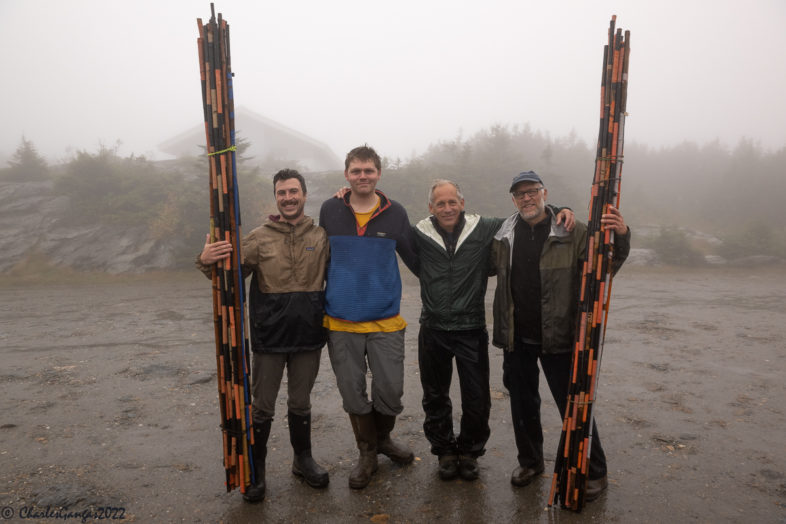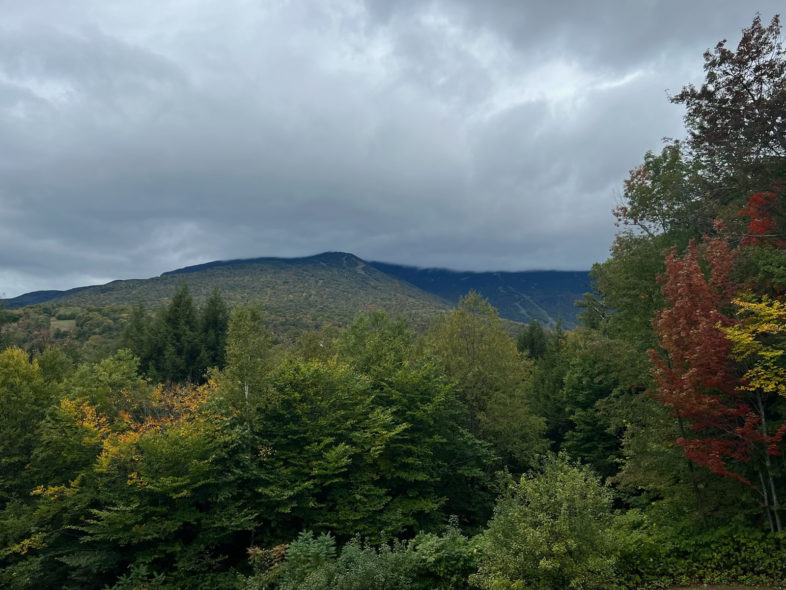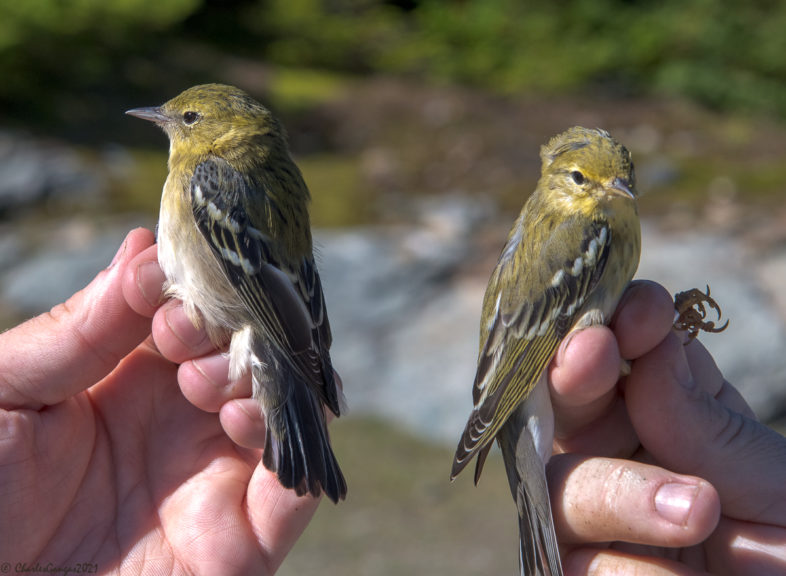
The VCE banding crew managed smiles and good humor despite a wet, chilly season finale that yielded few birds, and no Bicknell’s Thrushes. © Charles Gangas
Weather spares no one, and VCE’s wrap-up 2022 banding session on Mansfield exemplified the adage. Our well-laid plan to spend the nights of 19-20 September on our ridgeline study plot—strategically timed to coincide with the annual pre-migratory resurgence of Bicknell’s Thrush (BITH) activity—was thwarted by unseasonably cold, wet conditions. If anything, studying this bird for >30 years has instilled patience and flexibility, so we waited for the weather to turn, knowing that each day’s delay reduced our chances of intercepting any BITH that remained, let alone recovering another precious GPS tag or two. We scanned the mountain forecast hourly, eagerly seeking a break, but rain and chilly winds prevailed. We lowered our sights from two nights to one; we even conceded to head up on Saturday or Sunday. No go. Finally, 8 days after our original planned outing, we gambled on a tenuous but less than dire forecast and went for it.

The Mansfield ridgeline was bathed in clouds on 27 September, but Team VCE ascended and managed to open >20 mist nets, though avian activity was low. © Charles Gangas
A skeleton crew of Kevin Tolan, Nathaniel Sharp, Jim Goetz, Chuck Gangas, and I met at the base of the toll road at 3:45 pm on 27 September. Each of us having driven through rain squalls, we warily eyed the cloud-shrouded ridgeline above, but there was no turning back. Up we caravaned, and the clouds magically lifted just enough upon arrival to fuel confidence that setting nets might not be an atrocious idea. By 6 pm, we had 22 nets open, with Lake Champlain unexpectedly visible below us in our west. However, vegetation was soaked, the temperature hovered at 45F, and a south wind blew. Avian activity was anything but frenetic, and we failed to see, hear or capture a single BITH. Our evening take was 13 birds of 6 species, and we closed nets at 7 pm, retreating downslope to the dry comfort of Vail’s ski patrol hut. No sleeping bags under the stars on this night.
We awoke to swirling clouds, spitting rain, and 45F. As soon as we opened nets, showers intensified, and we quickly closed. A large cell showed on the radar maps, so we headed back down to the ski patrol hut for coffee. An hour later at 8 am, rain let up, radar images looked more promising, and we hustled back to the ridgeline. No sooner had we reopened than rain again descended. Realism triumphed over wishful thinking, and we conceded defeat. Nets came down, poles were lashed together for winter storage, and our field season ended unceremoniously. Disappointing, yes, as our September banding had never before failed to produce, both for BITH and migrants. Our total capture of 23 birds (below) was a far cry from 2021’s bounty of 222—of which 101 were kinglets—and any BITH that might still have been present eluded us.
Ruby-crowned Kinglet — 5
Golden-crowned Kinglet — 8
Dark-eyed (Slate-colored) Junco — 5
White-throated Sparrow — 1
Blackpoll Warbler — 2
Yellow-rumped (Myrtle) Warbler — 2
Ever optimistic, we consoled ourselves with the fruits of an otherwise highly successful 2022 season, during which we recovered 17 GPS tags that have so far revealed astonishing insights on precise movements and locations of non-breeding BITH. And, our final banding session did yield one avian highlight: an unusually bulked-up Blackpoll Warbler, which weighed in at a chunky 18 grams, fully 6-7 grams heavier than the weight of a typical breeding bird. This individual’s heavy fat score indicated its readiness to launch one of the planet’s truly epic migratory feats—a nonstop transoceanic flight of 1,500 miles or more to wintering grounds in northern South America. As we wished it well on this arduous, perilous journey, we looked ahead to our 32nd field season in 2023, and the promise of intercepting more BITH that return with fascinating spatial secrets encoded in their GPS tags.

Two immature migrant Blackpoll Warblers banded on Mt. Mansfield in September of 2021 (it was too wet to photograph our 2022 banded Blackpolls!). This species undertakes one of the planet’s most spectacular migratory flights each fall, flying non-stop over open ocean for 1,500 miles or more to its South American wintering grounds. VCE’s 2013-14 research using light-level geolocators on Mansfield birds helped document this astounding feat. © Charles Gangas

We’ll, no one can say you didn’t give it your all to go out with a bang! Congratulations on finishing another important and productive season on Mt Mansfield.